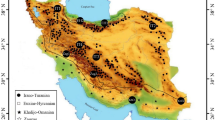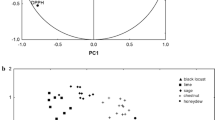Abstract
Sixteen honeydew and 15 floral honeys from Lebanon were analyzed for pollen spectra and physicochemical parameters. A total of 37 families and 67 taxa were recorded with the honeybees producing honeydew honey exhibiting a more diverse foraging behavior than those making floral honeys. The honeydew and floral honeys exhibited differences in moisture content, pH, electrical conductivity, color, protein and Maillard reaction products. The honeydew honeys contained more total phenols, had higher antioxidant contents, and displayed higher antioxidant capacities than the floral samples in the Trolox equivalent antioxidant capacity, oxygen radical absorbance capacity, inhibition of superoxide dismutase activity and protection of red blood cells against hemolysis assays. The honey samples exhibited higher antioxidant capacities, in the aforementioned assays, than their corresponding methanol-extractable phenol fractions although the differences did not reach statistical significance in the floral samples. The relative antioxidant capacity indices which integrate measures of antioxidant capacity from the different assays of the honey samples and their corresponding extracts exhibited similar patterns (r = 0.9774, 0.9937) thereby indicating that the antioxidative behavior of the entire honeys is mirrored by their methanol-extractable phenolic fractions.

Similar content being viewed by others
References
Ajibola A (2015) Novel insights into the health importance of natural honey. Malays J Med Sci 22:7–22
Al ML, Daniel D, Moise A, Bobis O, Laslo L, Bogdanov S (2009) Physico-chemical and bioactive properties of different floral origin honeys from Romania. Food Chem 112:863–867
Alvarez-Suarez JM, Gonzalez-Paramas AM, Santos-Buelga C, Battino M (2010) Antioxidant characterization of native monofloral Cuban honeys. J Agric Food Chem 58:9817–9824
Alvarez-Suarez JM, Giampieri F, Gonzalez-Paramas AM, Damiani E, Astolfi P, Martinez-Sanchez G, Bompadre S, Quiles JL, Santos-Buelga C, Battino M (2012) Phenolics from monofloral honeys protect human erythrocyte membranes against oxidative damage. Food Chem Toxicol 50:1508–1516
Bath KP, Singh N (2001) Effect of microwave heating on hydroxymethylfurfural formation and browning in Helianthus annuus and Eucalyptus lanceolatus honey. J Food Sci Technol 38:366–368
Beretta G, Granata P, Ferrero M, Orioli M, Facino RM (2005) Standardization of antioxidant properties of honey by a combination of spectrophotometric/fluorimetric assays and chemometrics. Anal Chim Acta 533:185–191
Bradford MM (1976) A rapid and sensitive method for the quantitation of microgram quantities of protein utilizing the principle of protein-dye binding. Anal Biochem 72:248–254
Brudzynski K, Miotto D (2011) The relationship between the content of Maillard reaction-like products and bioactivity of Canadian honeys. Food Chem 124:869–874
Can Z, Yildiz O, Sahin H, Turumtay EA, Silici S, Kolayli S (2015) An investigation of Turkish honeys: their physico-chemical properties, antioxidant capacities and phenolic profiles. Food Chem 180:133–141
Chua LS, Lee JY, Chan GF (2015) Characterization of the proteins in honey. Anal Lett 48:697–709
Cimpoiu C, Hosu A, Miclaus V, Puscas A (2013) Determination of the floral origin of some Romanian honeys on the basis of physical and biochemical properties. Spectrochim Acta A 100:149–154
da Silva PM, Gauche C, Gonzaga LV, Costa ACO, Fett R (2016) Honey: chemical composition, stability and authenticity. Food Chem 196:309–323
Diez MJ, Andres C, Terrab A (2004) Physicochemical parameters and pollen analysis of Moroccan honeydew honeys. Int J Food Sci Technol 39:167–176
Dong R, Zheng Y, Baojun XuB (2013) Phenolic profiles and antioxidant capacities of Chinese unifloral honeys from different botanical and geographical sources. Food Bioprocess Technol 6:762–770
Erejuwa OO, Sulaiman SA, Wahab MSA (2012) Honey: a novel antioxidant. Molecules 17:4400–4423
Escuredo O, Fernandez-Gonzalez M, Seijo MC (2012) Differentiation of blossom honey and honeydew honey from Northwest Spain. Agriculture 2:25–37
Ferreira ICFR, Aires E, Barreira JCM, Estevinho LM (2009) Antioxidant activity of Portuguese honey samples: different contributions of the entire honey and phenolic extract. Food Chem 114:1438–1443
Flanjak I, Kenjeric D, Bubalo D, Primorac L (2016) Characterisation of selected Croatian honey types based on the combination of antioxidant capacity, quality parameters, and chemometrics. Eur Food Res Technol 242:467–475
Gheldof N, Wang XH, Engeseth NJ (2002) Identification and quantification of antioxidant components of honeys from various floral sources. J Agric Food Chem 50:5870–5877
Gillespie KM, Chae JM, Ainsworth EA (2007) Rapid measurement of total antioxidant capacity in plants. Nat Protoc 2:867–870
Han RM, Zhang JP, Skibsted LH (2012) Reaction dynamics of flavonoids and carotenoids as antioxidants. Molecules 17:2140–2160
Hermosín I, Chicón RM, Cabezudo MD (2003) Free amino acid composition and botanical origin of honey. Food Chem 83:263–268
Iglesias MT, Martín-Alvarez PJ, Polo MC, de Lorenzo C, Pueyo E (2006) Protein analysis of honeys by fast protein liquid chromatography: application to differentiate floral and honeydew honeys. J Agric Food Chem 54:8322–8327
IHC (2009) Harmonised Methods of the International Honey Commission (2009) http://www.ihc-platform.net/ihcmethods2009.pdf. Accessed 10 May 2016
Karabagias IK, Dimitriou E, Kontakos S, Kontominas MG (2016) Phenolic profile, colour intensity, and radical scavenging activity of Greek unifloral honeys. Eur Food Res Technol. doi:10.1007/s00217-015-2624-6
Kędzierska-Matysek M, Florek M, Wolanciuk A, Skałecki P, Litwińczuk A (2016) Characterisation of viscosity, colour, 5-hydroxymethylfurfural content and diastase activity in raw rape honey (Brassica napus) at different temperatures. J Food Sci Technol 53:2092–2098
Lev E (2003) Traditional healing with animals (zootherapy): medieval to present-day Levantine practice. J Ethnopharmacol 85:107–118
Louveaux J, Maurizio A, Vorwohl G (1978) Methods of melissopalynology. Bee World 59:139–157
Manzanares AB, Hernandez ZG, Galdon BR, Rodriguez ER, Romero CD (2011) Differentiation of blossom and honeydew honeys using multivariate analysis on the physicochemical parameters and sugar composition. Food Chem 126:664–672
Meda A, Lamien CE, Romito M, Millogo J, Nacoulma OG (2005) Determination of the total phenolic, flavonoid and proline contents in Burkina Fasan honey, as well as their radical scavenging activity. Food Chem 91:571–577
MOE (2001) Ministry of Environment. Lebanon State of the environment report. http://www.moe.gov.lb/getattachment/The-Ministry/Reports/State-Of-the-Environment-Report-2001/Chap-10-Biodiversity.pdf.aspx. Accessed 10 May 2016
Oddo LP, Heard TA, Rodríguez-Malaver A, Pérez RA, Fernández-Muiño M, Sancho MT, Sesta G, Lusco L, Vit P (2008) Composition and antioxidant activity of Trigona carbonaria honey from Australia. J Med Food 11:789–794
Perez RA, Iglesias MT, Pueyo E, Gonzalez M, De Lorenzo C (2007) Amino acid composition and antioxidant capacity of Spanish honeys. J Agric Food Chem 55:360–365
Ramírez-Arriaga E, Navarro-Calvo LA, Díaz-Carbajal E (2011) Botanical characterization of Mexican honeys from a subtropical region (Oaxaca) based on pollen analysis. Grana 50:40–54
Sancho MT, Pascual-Mate A, Rodrıguez-Morales EG, Oses S, Escriche I, Periche A, Fernandez-Muino MA (2016) Critical assessment of antioxidant-related parameters of honey. Int J Food Sci Technol 51:30–36
Saxena S, Gautam S, Sharma A (2010) Physical, biochemical and antioxidant properties of some Indian honeys. Food Chem 118:391–397
Serem JC, Bester MJ (2012) Physicochemical properties, antioxidant activity and cellular protective effects of honeys from southern Africa. Food Chem 133:1544–1550
Singh N, Bath KP (1998) Relationship between heating and hydroxymethylfurfural formation in different honey types. J Food Sci Technol 35:154–156
Sun T, Tanumihardjo SA (2007) An integrated approach to evaluate food antioxidant capacity. J Food Sci 72:159–165
Tabart J, Kevers C, Pincemail J, Defraigne JO, Dommes J (2009) Comparative antioxidant capacities of phenolic compounds measured by various tests. Food Chem 113:1226–1233
Williams LJ, Abdi H (2010) Fisher’s least significant difference (LSD) test. In: Salkind N (ed) Encyclopedia of research design. Sage, Thousand Oaks, pp 491–494
Acknowledgements
Funding of the work was provided by the University Research Board of the American University of Beirut. The expert help of Ms. Zainab Rizk in the pollen analyses and Mr. Samson Atamian in collecting the samples is gratefully appreciated.
Author information
Authors and Affiliations
Corresponding author
Ethics declarations
The study has been approved by the Institutional Review Board of the American University of Beirut.
Conflict of interest
The authors declare that they have no competing interests.
Rights and permissions
About this article
Cite this article
Jaafar, K., Haidar, J., Kuraydiyyah, S. et al. Physicochemical, melissopalynological and antioxidant properties of artisanal honeys from Lebanon. J Food Sci Technol 54, 2296–2305 (2017). https://doi.org/10.1007/s13197-017-2667-8
Revised:
Accepted:
Published:
Issue Date:
DOI: https://doi.org/10.1007/s13197-017-2667-8




